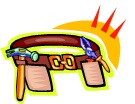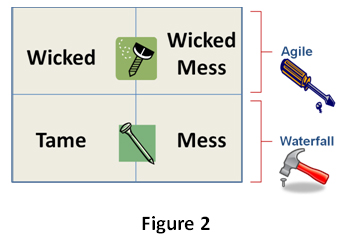Abraham Maslow once said “If the only tool you have is a hammer, you tend to see every problem as a nail.” This article provides the project manager (PM) / business analyst (BA) a framework for categorizing business problems as a baseline for selecting a solution development life cycle (SDLC). It concludes with a facilitation technique for conducting problem categorization and SDLC selection process. Key terms used are:
-
Tame, Mess, Wicked and Wicked Mess
-
Planed-Driven, Waterfall, Change-Driven, Agile
-
Value Chain
-
Six Thinking Hats
It is good practice to plan an action prior to taking an action. Unfortunately, many of us (PMs and BAs) take on a project without some initial thought on the nature of the problem that lies before us. We carry a notion that all endeavors are the same. And as a result, we address all projects in the same manner. For some of us, it is a plan-driven approach; for others, it is a change-driven approach (1).
Plan-driven SDLC
 The plan-driven approach is the traditional linear approach of sequential phases: gather data, analyze data, formulate a solution, and finally implement a solution. We call this traditional approach “waterfall.” It is based on the notion that the problem and the solution requirements can be predefined upfront. This approach was galvanized in the manufacturing and construction industries. Quality under this SDLC is defined as conformance to written and approved requirements.
The plan-driven approach is the traditional linear approach of sequential phases: gather data, analyze data, formulate a solution, and finally implement a solution. We call this traditional approach “waterfall.” It is based on the notion that the problem and the solution requirements can be predefined upfront. This approach was galvanized in the manufacturing and construction industries. Quality under this SDLC is defined as conformance to written and approved requirements.
Change-driven SDLC
 The change-driven approach in comparison to plan-driven approach is relatively new. We call this new approach “agile.” It had its origin in the software industry. Instead of sequential phases, it consists of iterations; each iteration addresses portions of the problem until the solution is good enough or funds are exhausted. It is based on the notion is that the problem and the solution requirements evolve over time. Quality under this SDLC is defined as “fit for use."
The change-driven approach in comparison to plan-driven approach is relatively new. We call this new approach “agile.” It had its origin in the software industry. Instead of sequential phases, it consists of iterations; each iteration addresses portions of the problem until the solution is good enough or funds are exhausted. It is based on the notion is that the problem and the solution requirements evolve over time. Quality under this SDLC is defined as “fit for use."
Tame, Mess, Wicked, and Wicked Mess Problems (2)
All endeavors are not the same. In fact they can be quite different in nature. We can view problems in four basic categories (see Figure 1):
-
Tame – issues can be clearly defined, few stakeholder are involved, problem root cause analysis leads to alternate solutions that converge into a single possible solution (i.e., resolution is definitive)
-
Mess – tame, but has the complexity of interrelated issues, suboptimal solutions pose other problems
-
Wicked – issues are difficult to define and change with time, several stakeholders are involved, problem root cause analysis leads to alternate solutions that diverge into other possible solutions (i.e., each resolution creates new issues)
-
Wicked Mess – wicked and has the complexity of interrelated issues, suboptimal solutions pose other problems

Tame and mess problems are technical in nature. Examples of tame and mess problems are fixing a broken part of a machine and adjusting a subprocess of a value chain (3) respectively. We replace the machine part and the problem is easily resolved. Note tame problems are not necessarily simple; they can be complex. Adjusting a value chain is more of a balancing act due to the interrelated subprocesses. When a broken subprocess is fixed, it may have a negative impact on other subprocesses. As a result, the adjustment has to be from the point of view of the value chain not just the subprocess.
Wicked and wicked mess problems may also be technical in nature. However, their distinguishing characteristic is vagueness of the problem – most often found in social problems. In fact, the aspects of the problem may change over time. An example of a wicked problem is attempting to fix a machine with a lack of understanding of the problem; we replace a part only to realize the problem is not resolved. This same problem becomes a wicked mess when interrelated issues cause new problems to be realized when a solution is applied.
Facilitation for Determining the Problem Nature and the Appropriate Tool
 Someone said, “It is a poor worker that blames the tools.” Indeed, it is the analyst’s responsibility to choose the correct tool to address the problem. As stated above, it is good practice to plan an action prior to taking an action. Given the variety of problems, part of this planning effort needs to be a thorough discussion in which category a problem lies prior to hammering or tweaking out a solution.
Someone said, “It is a poor worker that blames the tools.” Indeed, it is the analyst’s responsibility to choose the correct tool to address the problem. As stated above, it is good practice to plan an action prior to taking an action. Given the variety of problems, part of this planning effort needs to be a thorough discussion in which category a problem lies prior to hammering or tweaking out a solution.
One technique for facilitating this discussion is the “Six Thinking Hats” developed by Edward de Bono (4). I recommend the following sequence of parallel thinking discussions:
-
Blue Hat – discuss the objective of problem categorization and SDLC selection. Introduce the tame, mess, wicked, wicked mess framework, possible SDLC approaches, the six thinking hats process and the hat sequence that will be used.
-
White Hat – discuss only what is known (facts) and not known about the problem; like the character Detective Joe Friday, “Just the facts ma'am," on the famous series “Dragnet” (5). Assumptions may be included, but they must be later confirmed as facts.
-
Red Hat – discuss only intuitive likes, dislikes, fears, hunches, and gut feelings about the problem
-
Blue Hat – categorize the problem within the tame, mess, wicked, wicked mess framework based on the white and red hat discussions. Note: It may be possible to decompose a problem into issues with different natures. For example, you may choose to address the mess of a value chain first (process improvement project) and then proceed to build a software solution for a tame/wicked problem needed within the value chain.
-
Black Hat – discuss only the threats of addressing the problem
-
Yellow Hat – discuss only opportunities of addressing the problem
-
Green Hat – discuss only how to address the threats and opportunities identified in the black and yellow hat discussions
-
Blue Hat – choose the SDLC(s) based on the green hat discussion; use a decision making technique such as multi-voting or criteria based grid if necessary
-
White Hat – return to the white hat and assess the results
-
Blue Hat – ask for feedback on any process and capture lessons learned

Wrap-up
This article provides PMs and BAs some insight on categorizing a problem and choosing a solution development approach. Hopefully, the above discussion helps you determine if a problem is a “nail or a screw” as shown in figure 2 and choose the appropriate tool.
The title is derived from my favorite spaghetti western: “The Good, the Bad, and the Ugly.” Not sure if tame problems can be viewed as good, but messes are definitely bad and certainly wicked problems are ugly.
References
-
International Institute of Business Analysis (IIBA), A Guide to the Business Analysis Body of Knowledge® (BABOK® Guide)
-
Hancock, David, Tame Problems and Wicked Messes: Choosing Between Management and Leadership Solutions, RMA Journal (July/August 2004)
-
Porter, Michael (1998), Competitive Advantage: Creating and Sustaining Superior Performance, Free Press
-
de Bono, Edward (1999), Six Thinking Hats, Back Bay Books
-
Webb, Jack (2005 release), Just The Facts Ma'am: The Warner Bros. Recordings
 About: Mr. Monteleone holds a B.S. in physics and an M.S. in computing science from Texas A&M University. He is certified as a Project Management Professional (PMP®) by the Project Management Institute (PMI®), a Certified Business Analysis Professional (CBAP®) by the International Institute of Business Analysis (IIBA®), a Certified ScrumMaster (CSMTM) and Certified Scrum Product Owner (CSPOTM) by the Scrum Alliance, and certified in BPMN by BPMessentials. He holds an Advanced Master’s Certificate in Project Management (GWCPM®) and a Business Analyst Certification (GWCBA®) from George Washington University School of Business. Mark is the President of Monteleone Consulting, LLC and can be contacted via e-mail – [email protected].
About: Mr. Monteleone holds a B.S. in physics and an M.S. in computing science from Texas A&M University. He is certified as a Project Management Professional (PMP®) by the Project Management Institute (PMI®), a Certified Business Analysis Professional (CBAP®) by the International Institute of Business Analysis (IIBA®), a Certified ScrumMaster (CSMTM) and Certified Scrum Product Owner (CSPOTM) by the Scrum Alliance, and certified in BPMN by BPMessentials. He holds an Advanced Master’s Certificate in Project Management (GWCPM®) and a Business Analyst Certification (GWCBA®) from George Washington University School of Business. Mark is the President of Monteleone Consulting, LLC and can be contacted via e-mail – [email protected].